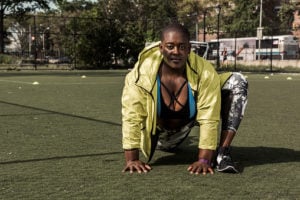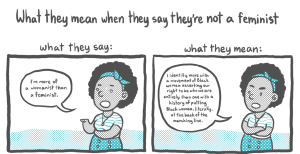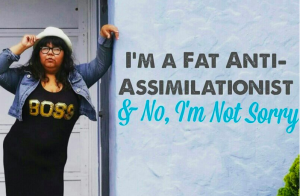A few days ago, a woman who writes for a self-identified feminist online women’s fitness publication tweeted something along the lines of: “Here’s a body-positive, evidence-based post to help you reach your goals [emphasis mine].”
When I clicked on the link, I was taken to a post about strength training for fat loss.
Huh.
I looked back at the tweet to make sure my eyes hadn’t deceived me, and there it was: a social media post promising body positivity accompanied by an article about targeted and intentional fat loss.
If it were just an article about intentional fat loss, I’d have an issue with it on the basis that fat loss and weight loss are only potential side effects of lifestyle change, and as soon as you add intention to the mix, you’re engaging in an act of warfare against your body that’s usually a result of cultural conditioning against fatness. That’s bad enough.
But it wasn’t “just” about that.
By using the phrase “body positive,” the author was attempting to justify the intentional changing of your weight as a values-neutral action.
Here’s why that’s wrong – and incredibly harmful to her readers.
1. Body Positivity Actually Has a Specific Definition
Once upon a time, the phrase “body positive” had a specific meaning – one that signaled to the reader that the content with which they were about to engage was (at least going to attempt) to not be oppressive, harmful, or triggering.
The term “body positivity” was borne out of treatment for anorexia recovery in 1996, when a psychotherapist and a woman who had personal experience with an eating disorder founded thebodypositive.org.
The methodology and messaging behind their lectures, workshops, and other resources all centered on messaging about reducing focus on changing body weight through disordered eating and exercise.
In fact, the first of the core competencies of body positivity is to learn how to “[u]ncover the messages that have influenced your relationships with your body, food, and exercise [and d]evelop a weight-neutral, health-centered approach to self-care [to b]ecome the authority of your own body by sorting out facts from distorted societal myths about health, weight, and identity.”
It’s clear that one of the influences on body positivity was fat acceptance and Health at Every Size.
Fat acceptance is specifically political and centered on equal rights, representation, and treatment for fat people, while Health at Every Size suggests that health and fitness are not measurable in body weight and can be achieved through intuitive eating, exercise, and self-care.
Eventually, as body positivity picked up steam and took on a secondary messaging that “all bodies are beautiful,” it became a fair-weather sister to the these fat accepting movements, sometimes running parallel and often subsuming fat positivity under its umbrella, attempting to become both the language of healing and the language of liberation
Once a movement hits the mainstream, it runs the risk of being diluted – or worse, capitalized upon – and that’s exactly what’s happened to body positivity.
When a message that’s meant to keep people from engaging in eating disordered behavior is presented to a population that doesn’t have or fully understand eating disorders, those people have to contextualize it in a way that they understand.
And, let’s face it: We could all stand to engage in a little less weight-loss obsession. The idea that we can be positive about our bodies and focus less on beating them into submission is a pretty marketable one – kind of like “girl power” feminism.
Thus, body positivity moved from eating disorder recovery and fat activism into the realm of mainstream social movements – one that’s been used to sell everything from actually “body positive” plus-sized clothing to body-neutral soap and body-negative magazines.
The definition was effectively diluted and distorted because it looks good on a T-shirt – and now that T-shirt only fits bodies of a certain size.
But knowing what we know about what body positivity originally stood for, it’s time for us to collectively decide to return to those intended goals and ideologies in an effort to reduce harm.
2. Body Positivity Isn’t What You Think It Is
The problem with body positivity is that “positivity” is both misleading and a misnomer.
What “positivity” suggests is that people should feel positive about their bodies, so whatever steps they take to “feel positive” are, inherently, productive and useful.
Now, here’s the problem: You and I live in a culture where we’re bombarded on all sides with messaging that tells us that people with thin/lean/muscular bodies are happier and healthier.
We’re told that access to that happiness and health only comes with the physical manipulation of our bodies’ fat deposits. Ergo, we tell ourselves, any steps you make to reduce those fat deposits are body positive.
However, the original definition – and the layered discourse that body positivity appropriated from fat acceptance – is about not intentionally manipulating your food and exercise in order to minimize body fat.
The actual intention of body positivity is not “any action that makes you feel positive about your body.” The intention is size acceptance.
Unfortunately, as “body positivity” was mainstreamed, it was used as an umbrella to discuss everything about our bodies from weight to acne to choice of toenail polish. It can even be trans-exclusive, because it’s an admonishment to accept all aspects of your body, without acknowledgment of dysphoria.
But body positivity shouldn’t be that. It’s not that.
Body positivity is about reducing potential disordered eating and distorted body image triggers, while reducing the oppressive language that excludes fat people from access to resources.
It can apply to, and be inclusive of, trans bodies (or at least it does in theory, even if not always in practice) because the intention isn’t to stop a person from modifying their body to evade dysphoria – it’s to stop them from trying to modify their weight at the expense of their physical and emotional health in order to achieve thin privilege.
The words “body positivity” are easily misconstrued, but that doesn’t change the intention behind them.
3. Body Positivity Doesn’t Change Meanings Just Because You Want It To
Let’s make something clear: Having a goal for intentional fat loss is not body positive.
Period.
That’s literally antithetical to the definition and intention of body positivity. Fat loss goals are about intentionally changing your body weight (in the context of weight loss).
Body positivity is about not intentionally changing your body weight. The two things don’t mix.
That doesn’t mean you can’t write a blog post about fat loss goals (although I wish you wouldn’t). What it means is that you can’t write a blog post about fat loss goals and throw a “body positive” label on it because that’s what you think your audience wants to hear.
This doesn’t mean that strength training, in general, is not body positive – body positivity and Health at Every Size use similar language to discuss exercise as a weight-neutral activity.
Body positivity isn’t about “letting yourself go” or never exercising again, nor is it about never doing any activity or making any changes that could result in weight loss as a possible – but not guaranteed – side effect.
However, body positivity is about not making exercise a means to a physical end – in other words, not about fat loss goals. If fat loss happens as a result of the actions you take to introduce intuitive and gentle healthy lifestyle changes, then it happens.
But if you’re attempting to use some “evidence-based approach” to reach a premeditated weight, size, or shape, then you’re not body positive.
That doesn’t mean that you don’t care about your body. But it most certainly means that you’re not practicing body positivity.
I know that it’s zeitgeist-y to use the words “body positive” in your social posts or to advertise your products and services – that’s how you get likes, clicks, and sales. But if what you have to offer is literally antithetical to body positivity, then just don’t use the words “body positive” to advertise it.
Wanting something to be body positive doesn’t make it body positive.
Choosing to call it body positive when it isn’t doesn’t make it body positive. You don’t get to decide what is or isn’t body positive just because you want to be a part of the movement without giving up your beliefs about fat loss.
4. Word Choice Matters
How you identify your position on weight and fat loss matters.
The continuation of diet culture and the behaviors and mindset it promotes can have exponentially damaging effects on multiple populations – both people with eating disorders (of all sizes) and people who are driven to disordered eating and body image because they are oppressed by anti-fat language (again, of all sizes).
Body positivity is not a phrase available to be co-opted by anyone who feels that fat loss is positive – yet, we treat it as such because it aligns with people’s preconceived notions about weight loss and dieting.
Andi Zeisler discusses this phenomenon in her book We Were Feminists Once:
The business of marketing and selling to women literally depends on creating and then addressing female insecurity…There was good reason for industries that sustained themselves on the self-hatred of women to dread the potential reach of feminist movements. Co-opting the language of liberation to sell their products allowed them to have it both ways, celebrating the spirit of the movement while fostering a new set of insecurities (‘Natural-look’ cosmetics, anyone?) and a new aspirational archetype.
The fitness coach who posted her fat loss tweet was doing just this. She used the culture of oppression (“You’re too fat to be positive about your body”), but couched it in the language of liberation (“So here’s a ‘positive’ way to fix it!”).
When body positivity becomes a tool for perpetuating insecurity as a means to capitalize upon an aspirational diet or exercise program, it loses its effectiveness as a tool for liberation or for healing.
Words matter – because they are the containers that hold and deliver meaning. When those containers are manipulated so that the label remains, but the substance held inside is changed or perverted, you put entire populations at risk for harm.
If you want to be truly body positive, then teach others how exercise can be used intuitively and as an “evidence-based” tool for maintaining and improving cardiovascular health or bone density.
If you want to “empower” your clients or family members or friends to learn how to lift weights and find the fun in fitness, then use weight-neutral language to introduce them to the gym.
And if you prefer to sell strength training as fat loss, then do that. But know that the language with which you sell your services matters. Call it fat loss, call it body changing – but please don’t call it body positive.
[do_widget id=’text-101′]
Kaila Prins is a drag queen trapped in a cis woman’s body, performing “woman” through body-positive burlesque under the name DeeDee Queen. You can watch her feminist one-woman burlesque show at performingwoman.com/lovely; read her unpopular opinions about feminism, marketing, body image, eating disorder recovery, and more at her website, or find her on Instagram @performingwoman.
Search our 3000+ articles!
Read our articles about:
Our online racial justice training
Used by hundreds of universities, non-profits, and businesses.
Click to learn more





















